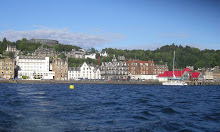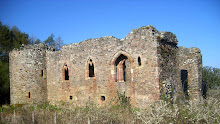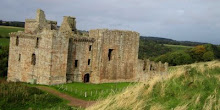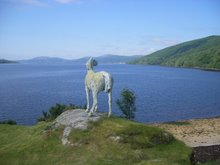Tuesday, May 15, 2012
The Queen's Unfortunate Love of Golf
Mary Queen of Scots (1542 - 1587) is reported to be the first woman to play golf regularly. Now some readers will know how that game can just get a hold of you; it clouds the judgement. So it was for Mary: people noticed that within days of the murder of her husband, Lord Darnley, the Queen was back out with her bag of golf sticks chasing that wee ball along the links. Of course it didn't help that fifteen weeks later she married the Earl of Bothwell, the man generally thought to be her husband's murderer.
Not only was Mary a golfer, but a fine horsewoman, poet, musician, and according to a contemporary "there was no human knowledge she could not talk upon... she used a most gentle style of speech, with kindly majesty mingled with modest reserve". She was also tall, athletic, beautiful. In fact she was just the sort of queen that Scotland needed in the 16th century. But it all went horribly wrong. Golf was the least of her problems; the biggest was... men; she fell in love with the wrong ones. It is a long and tragic story, related in many books and now by the excellent Scottish Portrait Gallery in an eTour.
But if you would like to see the castles and palaces where she was born and christened, where she lived and danced, prayed and plotted, you can now accompany Lord Sempill in a personal tour which fleshes out the life and loves of this extraordinary woman. A compelling story, well told.
Thursday, January 12, 2012
The Burning of the Clavie
Though my calendar shows 12 January, it is actually January 1st ... according to the Julian Calendar, accepted in Britain until 1752 (in Alaska until 1867 and Russia until 1917).
That means last night must have been Hogmanay and a night of celebration! And so it was for the folk of Burghead in North East Scotland who celebrate with a fire festival, the Burning of the Clavie, every 11 January.
A burning tar barrel is carried flaming through the streets and burning staves are given to residents to bring them luck in the New Year. Finally the clavie forms the nucleus of a bonfire on the rampart of an ancient Pictish fort. Burghead was the heart of the northern Pictish kingdom from the 4th century until destroyed by the Vikings in the 9th century.
What is it about Scotland and fire festivals? At Hogmanay in Stonehaven near Aberdeen locals make up balls of chicken wire which they fill with flammable material and march through the streets, swinging the burning balls round their heads, accompanied by a pipe band.
In Shetland at ceremonies called Up Helly Aa they throw burning torches into a replica viking ship.
It's all a wonderful excuse for bringing the community together and brightening up the long nights with a good bonfire and a party!
Thursday, December 22, 2011
Christmas for a King in 1716
The best known Jacobite rising was of course the 1745 which ended with the disastrous Battle of Culloden. But it was the 1715 that had the most chance of success. Queen Anne died in August 1714 and although there were 56 better claimants, a non English speaking (but Protestant) German princeling was brought over to be the next king. Many people were unhappy; there were impromptu riots in English cities and armed rebellions in northern England and Scotland. The rightful king, Bonnie Prince Charlie's father James, took an extraordinarily long time to lend his presence to those who wished to secure the crown for him. Had he come earlier, things might have been different!
James arrived (in disguise) at Peterhead on 23 December 1716 accompanied by just six gentlemen companions. No preparations had been made but he was offered the Earl Marischal's house at Fetteresso near Stonehaven. The Earl himself was in Perth with the Jacobite army, only arriving at Fetteresso on the 27th. The weather was foul and the king fell ill with the ague. He thus spent Christmas, still incognito, ill in bed in a strange, cold, house without a host or hostess (and a price of £100,000 on his head!). I doubt there were many presents.
My broken leg and I are being looked after by the excellent staff at Raigmore hospital, Inverness, this Christmas. It will be a whole lot more pleasant than that of the would-be James VIII of Scotland on his first visit to this country in 1716!
I wish you all a Christmas fit for a king!
PS. For more on Jacobites and Christmas, have a look at my last Christmas post.
James arrived (in disguise) at Peterhead on 23 December 1716 accompanied by just six gentlemen companions. No preparations had been made but he was offered the Earl Marischal's house at Fetteresso near Stonehaven. The Earl himself was in Perth with the Jacobite army, only arriving at Fetteresso on the 27th. The weather was foul and the king fell ill with the ague. He thus spent Christmas, still incognito, ill in bed in a strange, cold, house without a host or hostess (and a price of £100,000 on his head!). I doubt there were many presents.
My broken leg and I are being looked after by the excellent staff at Raigmore hospital, Inverness, this Christmas. It will be a whole lot more pleasant than that of the would-be James VIII of Scotland on his first visit to this country in 1716!
I wish you all a Christmas fit for a king!
PS. For more on Jacobites and Christmas, have a look at my last Christmas post.
Thursday, November 10, 2011
Remembrance Day
I was delighted to read that traffic in Inverness will stop for two minutes at 11.00 tomorrow, 11 November, to mark the memory of all those servicemen who fell in the First World War and subsequent conflicts. This move which augments tributes that will be paid at War Memorials throughout the land this Sunday is a welcome move to bring this extraordinary sacrifice into people's daily lives.
I was at Eilean Donan Castle recently, looking at the memorial to the MacRaes who gave their lives in the two wars. I re-read the poem by John MacRae, a Canadian, which led to the poppy becoming the emblem of Remembrance:
On the first day of the Battle of the Somme, 1 July 1916, the British Army suffered nearly 60,000 casualties - that's nearly the population of Inverness.
I, too, will be pausing for two minutes at 11.00 tomorrow.
I was at Eilean Donan Castle recently, looking at the memorial to the MacRaes who gave their lives in the two wars. I re-read the poem by John MacRae, a Canadian, which led to the poppy becoming the emblem of Remembrance:
In Flanders fields the poppies grow
Between the crosses, row on row,
That mark our place; whilst in the sky
The larks, still bravely singing, fly
Scarce heard amidst the guns below.
We are the dead. Short days ago
We lived, felt dawn, saw sunset glow,
Loved and were loved and now we lie
In Flanders fields.
We are the dead. Short days ago
We lived, felt dawn, saw sunset glow,
Loved and were loved and now we lie
In Flanders fields.
I, too, will be pausing for two minutes at 11.00 tomorrow.
Saturday, November 05, 2011
Guy Fawkes Day and the 'Winter Queen'
Today is an ideal Guy Fawkes Day - clear, crisp and a Saturday. There will be fireworks throughout the United Kingdom tonight and massive bonfires topped with a 'guy', a stuffed effigy of Guy Fawkes who, on 5 November 1605, hoped to make a bonfire of the Houses of Parliament thereby killing the king.
The king in question was King James VI of Scotland (right), son of Mary Queen of Scots, and recently crowned James I of England. Guy Fawkes and his co-conspirators were aggrieved that James, a Protestant (albeit with a Roman Catholic mother and wife) was not resisting anti-Catholic legislation.
The story twists and turns and is well told here and here. In essence the plot was that with the king and his elder son dead, his nine year old daughter Elizabeth would become Queen of a newly Catholic country. Well, Fawkes was discovered on 4 November and Elizabeth grew up to marry the German Frederick V, Elector Palatinate. For just a few months in the winter of 1619/1620 Frederick became King of Bohemia, and known as 'The Winter King'; thus Elisabeth acquired her moniker 'Winter Queen'.
Elisabeth, who was born in Falkland Palace in Fife and brought up at Linlithgow Palace near Edinburgh, would surely have considered herself a Scot; her portrait hangs in the Scottish National Portrait Gallery. It is therefore doubly ironic that Elizabeth whom Guy Fawkes wished to crown as a Catholic Queen is remembered principally as the Grandmother of George I, who was preferred to the Cathoic James Stuart, the exiled de jure king, when Queen Anne died in 1714. George, a Protestant, became the first monarch of the House of Hanover, leapfrogging more than 50 Roman Catholics who had a better claim to the throne! There followed 32 years of Jacobite Risings, seeking to right this perceived wrong.
Elizabeth died in England, whilst visiting her nephew Charles II who was fond of her and insisted that some of the 'barbarous' names in his new territories across the Atlantic were named after her, hence the Elizabeth River in Southeastern Virginia and Cape Elizabeth in Maine.
Happy Guy Fawkes Day!
The king in question was King James VI of Scotland (right), son of Mary Queen of Scots, and recently crowned James I of England. Guy Fawkes and his co-conspirators were aggrieved that James, a Protestant (albeit with a Roman Catholic mother and wife) was not resisting anti-Catholic legislation.
The story twists and turns and is well told here and here. In essence the plot was that with the king and his elder son dead, his nine year old daughter Elizabeth would become Queen of a newly Catholic country. Well, Fawkes was discovered on 4 November and Elizabeth grew up to marry the German Frederick V, Elector Palatinate. For just a few months in the winter of 1619/1620 Frederick became King of Bohemia, and known as 'The Winter King'; thus Elisabeth acquired her moniker 'Winter Queen'.
Elisabeth, who was born in Falkland Palace in Fife and brought up at Linlithgow Palace near Edinburgh, would surely have considered herself a Scot; her portrait hangs in the Scottish National Portrait Gallery. It is therefore doubly ironic that Elizabeth whom Guy Fawkes wished to crown as a Catholic Queen is remembered principally as the Grandmother of George I, who was preferred to the Cathoic James Stuart, the exiled de jure king, when Queen Anne died in 1714. George, a Protestant, became the first monarch of the House of Hanover, leapfrogging more than 50 Roman Catholics who had a better claim to the throne! There followed 32 years of Jacobite Risings, seeking to right this perceived wrong.
Elizabeth died in England, whilst visiting her nephew Charles II who was fond of her and insisted that some of the 'barbarous' names in his new territories across the Atlantic were named after her, hence the Elizabeth River in Southeastern Virginia and Cape Elizabeth in Maine.
Happy Guy Fawkes Day!
Subscribe to:
Posts (Atom)




























































